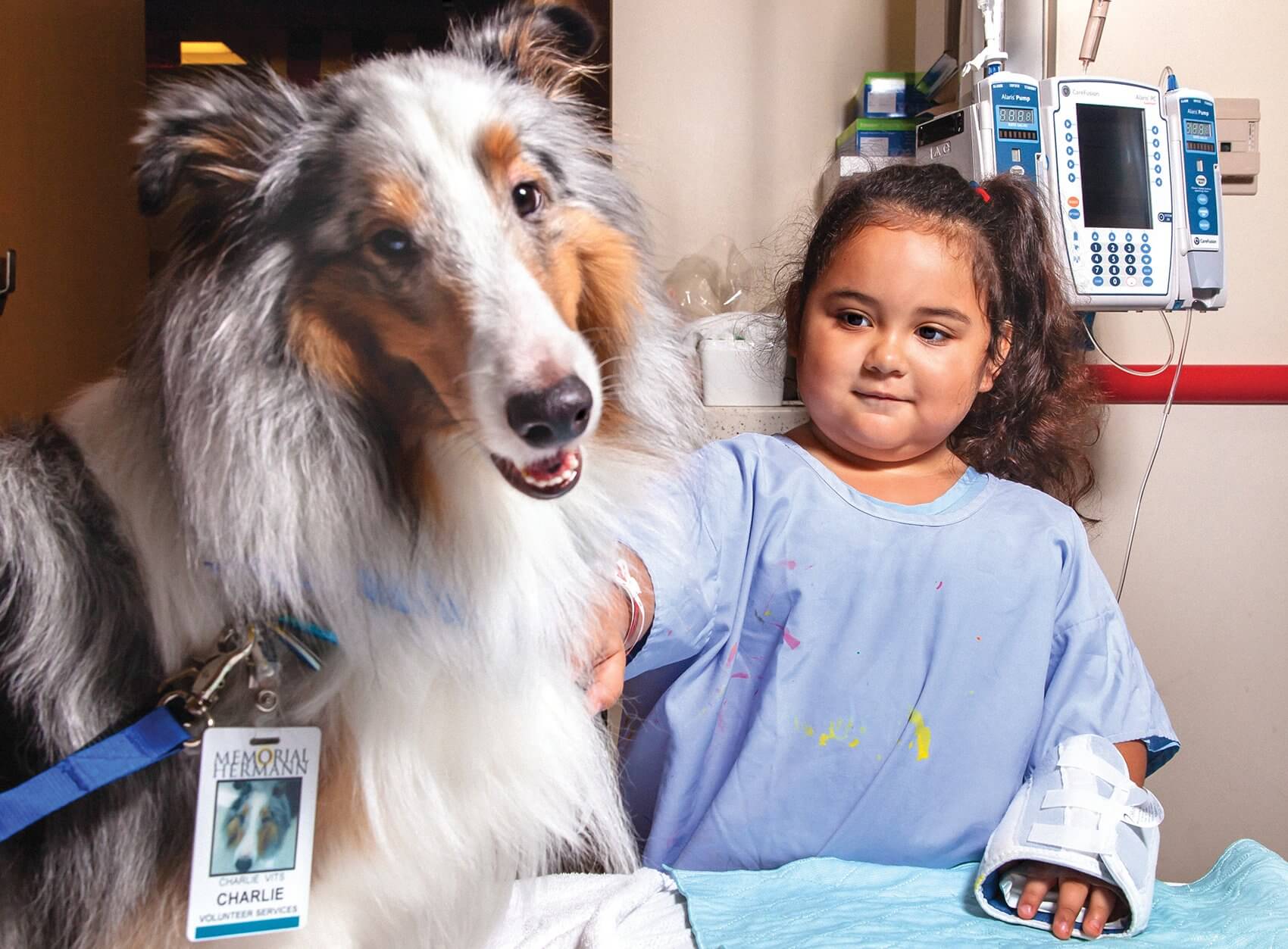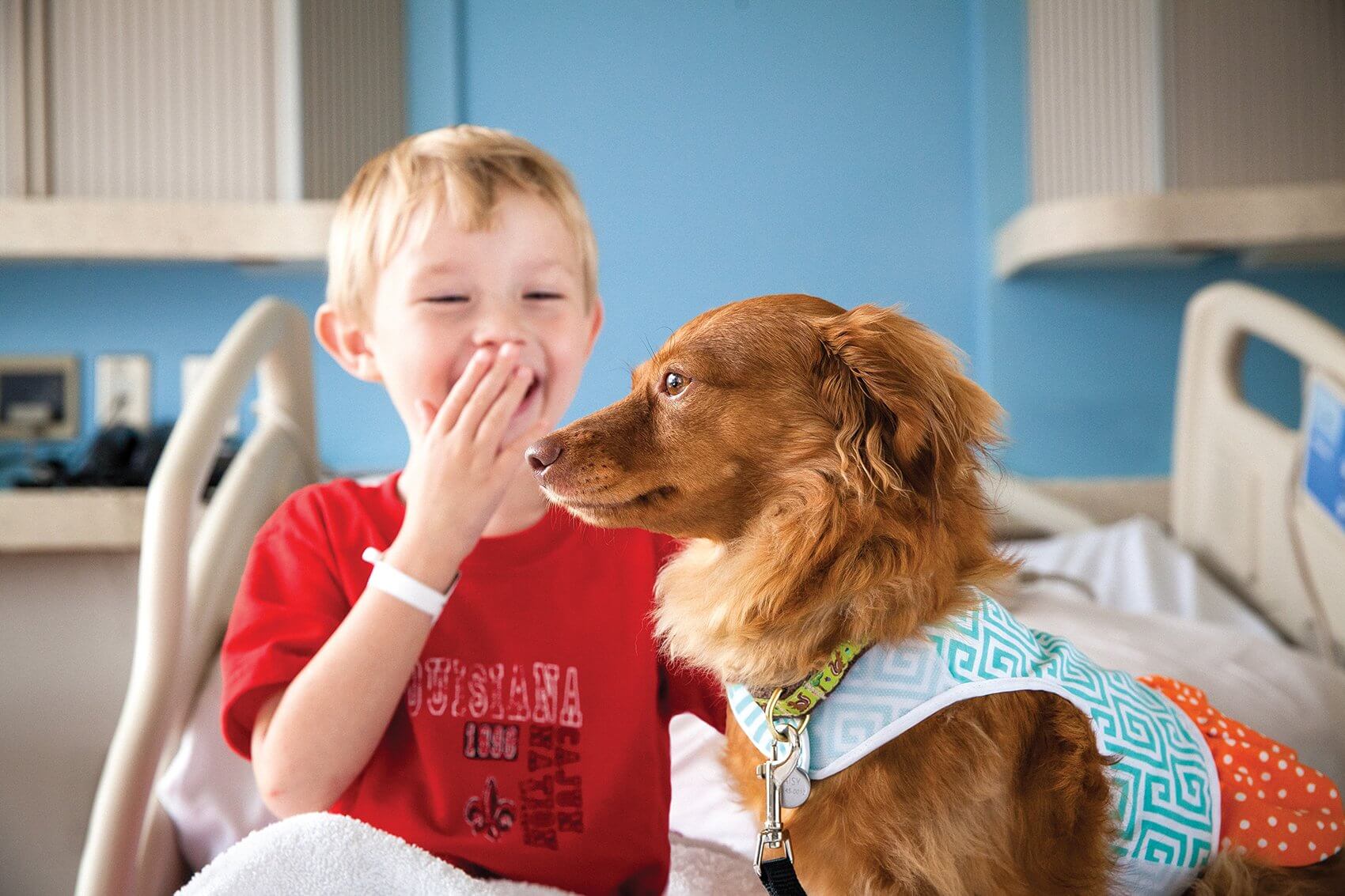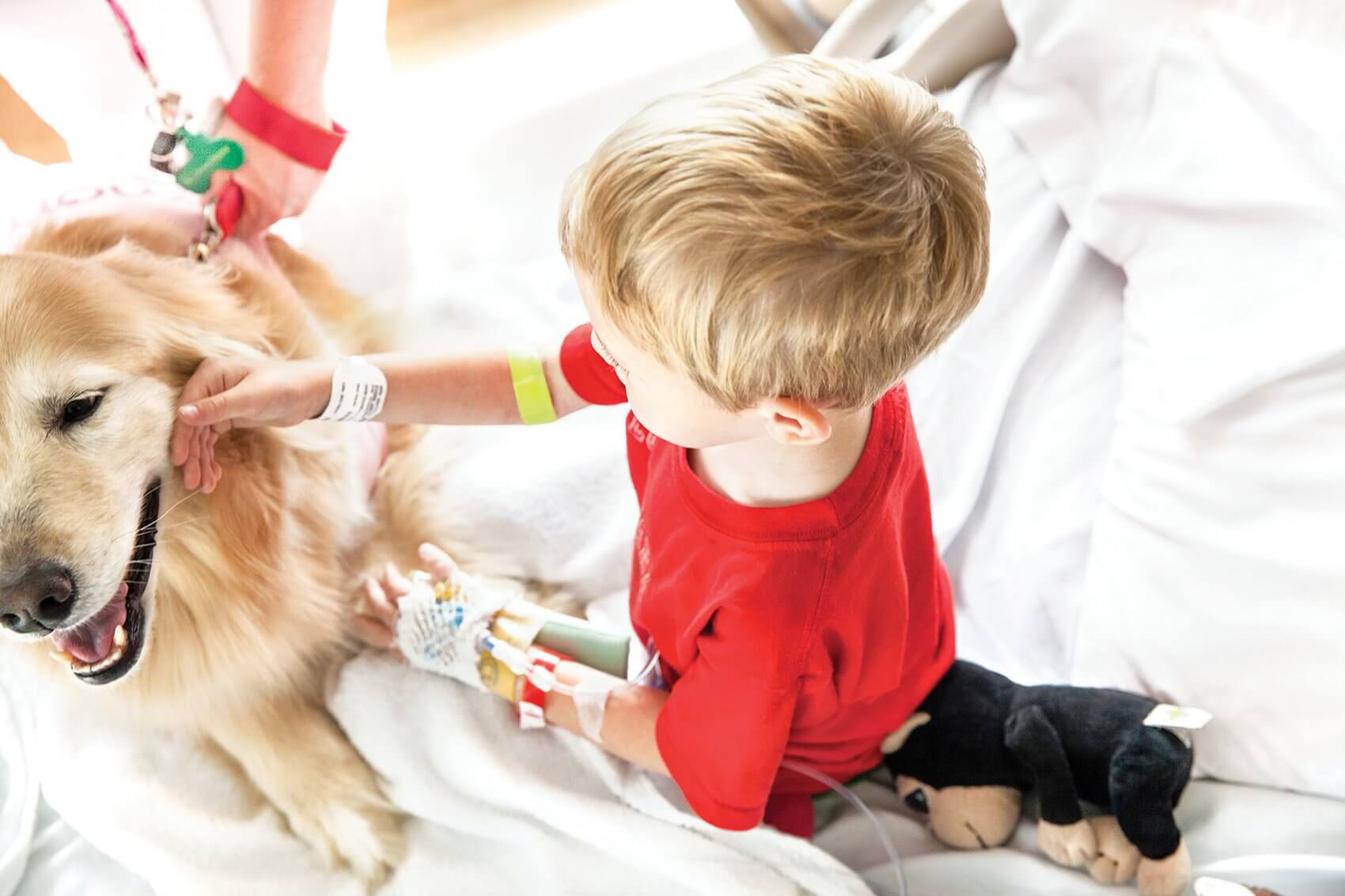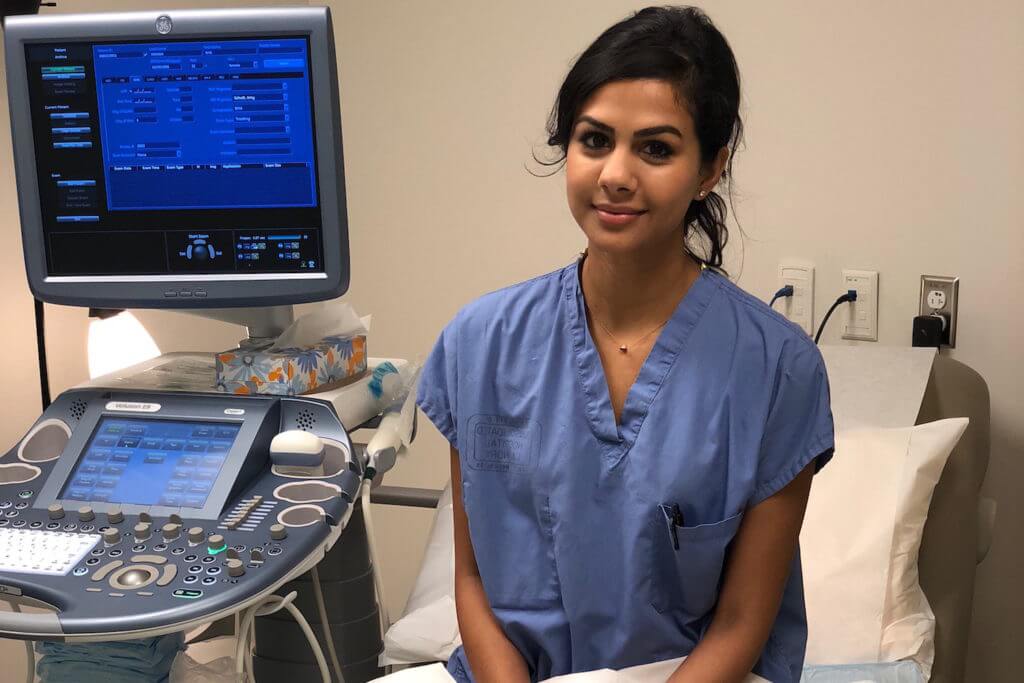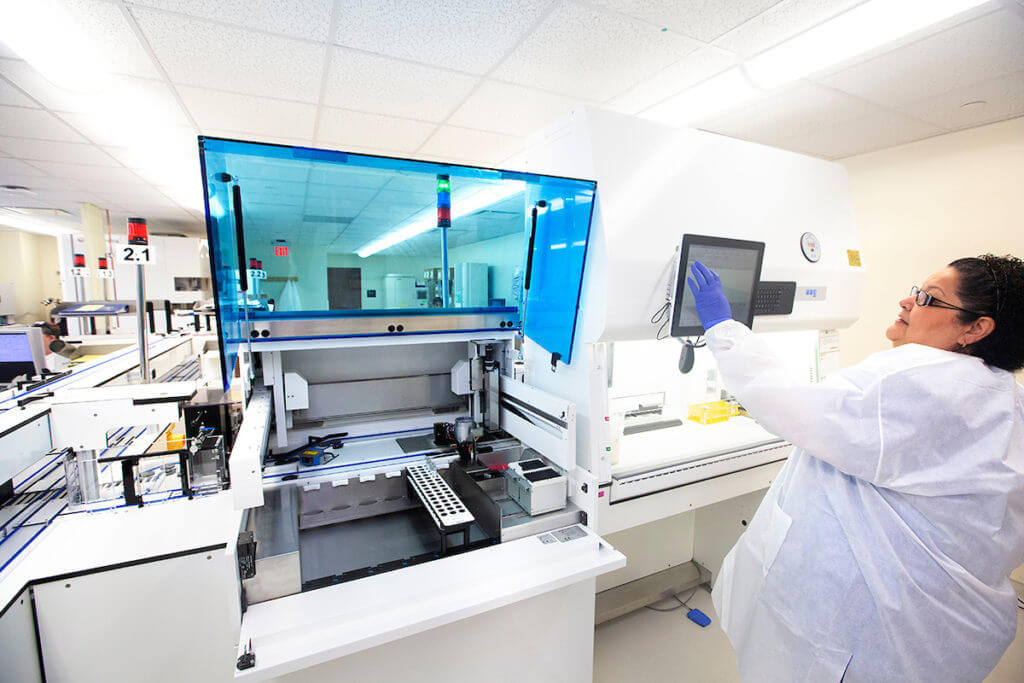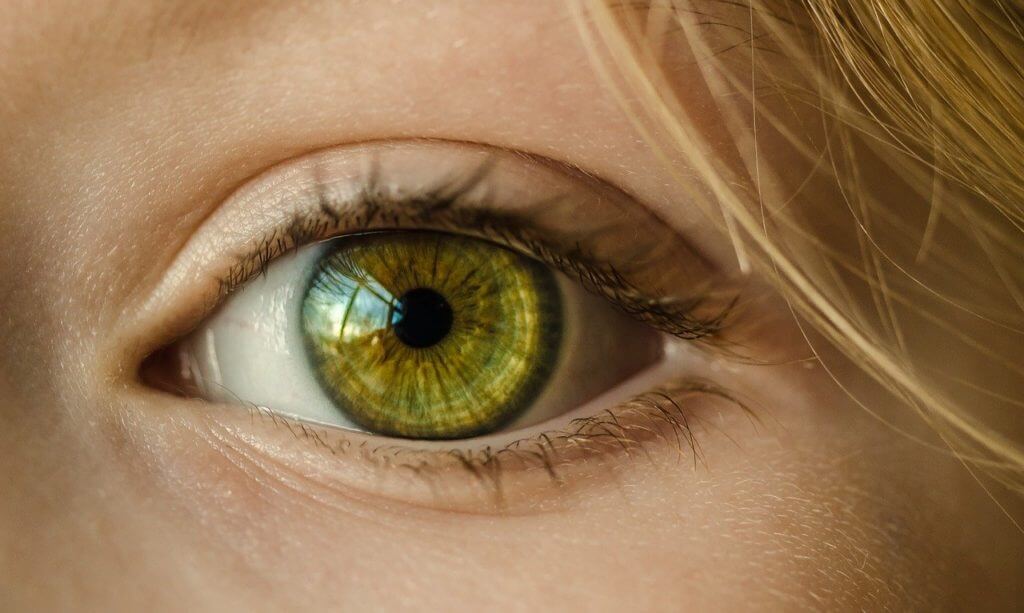Giving Paws

A few years ago, Connie Richards was walking down the familiar halls of Houston Methodist Hospital’s ICU, her yellow tabby Milo perched in his stroller, when she heard a woman call out.
“Is that a cat?”
Richards turned and smiled. She entered the room where the woman stood next to a patient in a coma, her husband, who had been unresponsive for days.
“My husband loves cats,” the woman said.
Richards lifted Milo out of his stroller and laid him across the patient’s chest. Milo purred while the woman took her husband’s hand and slowly drew it across Milo’s back. Over and over again, from Milo’s tawny crown to the tip of his tail, Richards watched as the woman helped her husband pet the soft fur. As her gaze shifted upward, she saw that the man had tears streaming down his face.
This is the power of pet therapy.
Also known as animal-assisted therapy, the increasingly recognized form of treatment engages animals in rehabilitation programs to help patients recovering from illness and injury. Richards, who is the founder and director of Faithful Paws, one of Houston’s long-standing animal-assisted therapy organizations, has been practicing pet therapy with her group for over 18 years. Her cat and three dogs actively serve as certified therapy pets.
“It’s incredible some of the breakthroughs I’ve witnessed,” said Richards. “Our mission is to provide unconditional love to people who are facing a rough time in their lives, and over the years we’ve seen how a simple interaction with animals can transform patients’ emotional, cognitive or social state.”
The positive effects of animal-assisted therapy have become so well known that institutions throughout the Texas Medical Center—including Memorial Hermann-Texas Medical Center, Children’s Memorial Hermann Hospital, Houston Methodist Hospital, Houston Hospice, DePelchin Children’s Center, Texas Children’s Hospital and The University of Texas MD Anderson Cancer Center, among others—have partnered with various local programs, including Faithful Paws, to provide the service. Caring Critters, another fixture in the TMC, was the first animal- assisted therapy program in the city and has been serving the Greater Houston health care community for over 27 years. Although the majority of therapy pets are dogs (as well as some singularly special cats), their program also boasts therapy bunnies, birds and an ever-popular miniature horse named Sasha on its roster.
Both organizations are volunteer-based and require a consistent time commitment of their members, as well as extensive training and adherence to the highest behavioral and hygienic standards. Faithful Paws mandates that all dogs larger than “pocket-sized” pass the American Kennel Club’s Canine Good Citizen obedience test in order to be eligible for volunteering, and every pet must be up-to-date on their shots, groomed and bathed prior to visitation.
“Presentation is a big concern of ours,” said Richards. “It’s crucial that we uphold a credible image, that our pets are well-behaved and groomed, and that we follow HIPAA and hospital guidelines when we visit a campus. Prior to each visit, our hospital liaisons communicate with physicians to make sure each visit is appropriate based on the patient’s condition and circumstances. What we do affects every pet therapy group in the United States—we’ve even had people from other countries contact us for permission to use information we’ve published on our website and the philosophy we’ve set out.”
The popularity of animal-assisted therapy is growing, thanks in no small part to the fact that its benefits are so vast and well documented—and, it seems, deeply rooted in our biology.
Archeological evidence suggests that canines have shared an evolutionary path with humans for at least 30,000 years, allowing for the development of a relationship that is simultaneously collaborative and reciprocal.
In 1984, the American biologist Edward O. Wilson examined this relationship more broadly and postulated that human beings’ urge to affiliate with other forms of life actually helps sustain life. Indeed, clinical studies have shown that animal-assisted therapy measurably improves health by lowering blood pressure, diminishing the release of harmful hormones, decreasing anxiety, stimulating positive changes in immune function and reducing symptoms of depression.
The studies are ongoing in hopes of securing further funding and shaping more programs. Researchers from the UTHealth School of Nursing, including Sandy Branson, Ph.D., Lisa Boss, Ph.D., Mara Baun, Ph.D., Duck-Hee Kang, Ph.D., and Nikhil Padhye, Ph.D., are currently conducting a randomized control trial with Children’s Memorial Hermann Hospital and Faithful Paws to evaluate anxiety, mood/affect, and biological stress responses in hospitalized children ages seven to 17 by comparing the responses between animal-assisted activity and non-animal assisted activity control groups. The study examines self-reported as well as biological responses measured through saliva, including cortisol and inflammatory markers—to determine just how substantial the influence can be on pediatric patients.
“Our mission is to provide unconditional love to people who are facing a rough time in their lives, and over the years we’ve seen how a simple interaction with animals can transform patients’ emotional, cognitive or social state.” — Connie Richards, Founder and Director of Faithful Paws
“It is so easy to see the positive impact of the visit by the dogs and their handlers,” said Richard Weir, director of Child Life and Expressive Therapies at Children’s Memorial Hermann Hospital. “Anxiety levels that often come with being in a clinical setting drop, almost palpably. The children and their families are amazed when the pack appears. They are surprised that there are actually dogs in the hospital! The toddlers become very excited and the older children want to get close, to touch and hug them. I’ve had the privilege of watching these dogs play a major role in the healing process for our patients.”
In addition to the significant clinical implications, animal-assisted therapy also stimulates socialization and conversation, or can simply offer entertainment or diversion from an illness or upcoming procedure.
“Our main goal with pet therapy is to comfort the patients,” said Amy Cesak, child life activity coordinator at Texas Children’s Hospital. “The animals really help normalize and socialize the hospital environment for them. A few months ago we had a little girl who refused to speak—she’d been here for at least three or four days and she wouldn’t say a word—but as soon as one of the dogs walked in, her face lit up and she began talking. She even got out of bed and followed the dog down the hallway and started interacting with the staff for the first time. It’s really neat to see how an animal can provide comfort in a totally different way than a human can.”
“You can’t even describe how happy it makes you to see a dog at your door,” said Kayla Deroche, an 18-year-old patient at MD Anderson Children’s Cancer Hospital during a recent pet-therapy session with Caring Critters. Deroche, who has been in and out of the hospital over the past 12 months, had been waiting all morning to see one therapy dog in particular: Denali, also known as “Deni,” a 6-year- old Great Pyrenees who was adopted by Christy and Stephen Almond just two days before she was scheduled to be euthanized in a shelter in Kentucky.
“I have three dogs at home and I was used to seeing them every day,” explained Deroche. “Last time Deni visited I couldn’t do anything—I hadn’t been able to eat for three weeks—so we just laid on the floor. She was the only reason I got out of bed.”
Along with visiting patient rooms, many hospitals in the TMC also utilize the therapy animals in their physical rehabilitation programs to help patients attain specific goals related to mobility, range of motion, or hand-eye coordination. Therapists will work with their patients on brushing an animal, tossing a ball for a game of fetch, or even assisting the handler with walking his or her dog through the hallways.
MD Anderson, in partnership with Caring Critters, offers a group rehabilitation session every Saturday in addition to their animal bedside visitation on their pediatric floor. Called the Welcoming Animals Giving Support (WAGS) program, participation requires a doctor’s order for animal- assisted physical therapy.
“Our volunteers help the patients move to the rehab area and they participate in rehabilitation-based structured activities with the dogs,” explained Brandon Floyd, hospital and clinic programs manager for the Department of Volunteer Services at MD Anderson. “It’s meant to feel like a gymnasium—a kind of recess, if you will—and it really takes the patients’ minds off the fact that they are engaging in a prescribed care activity that, for most of them, is actually very challenging.”
MD Anderson also partners with the local nonprofit PAWS Houston, which takes pet therapy a step further and works to bring patients’ own animals to their bedside. This service is offered through the hospital’s Palliative Care program, which focuses on relieving suffering and providing comfort to critically ill patients who may require end-of-life care. In addition to arranging and facilitating these invaluable visits, in many cases the organization can also provide foster care or in-home animal care for pets of those hospitalized individuals.
“It’s a unique opportunity for patients to say goodbye,” explained Jo-Anne Gaudet, pet therapy coordinator at Houston Methodist Hospital, who also works with PAWS Houston to provide this service. “For most people, their pets are a part of their family, and depending on the circumstance, sometimes even their best friend. We’ve watched how these visits can really help with depression or provide closure for a patient who is at the end of life. In looking at the person as a whole, if there’s something we can do to make their experience at Houston Methodist better, we’re going to make it happen.”
Whether it’s saying goodbye, cuddling on the floor or squeezing in a quick hug as the crew walks through the hallways, an animal’s presence is a welcome reprieve not only to the patients and their families, but to the hospital staff as well.
“When we go on a visit, we’re not just there for the patients,” said Richards. “The nurses, physicians, staff—they all benefit, too. I had this one doctor turn to mush when he took Milo in his arms. Here was this rough-and-tough-looking doctor and he was boo-boo talking to the cat. It’s amazing. On any given day, you never know who’s going to need that extra comfort.”
And as for the animals themselves?
“They love it,” said Dave Brady, a volunteer with Caring Critters whose dog, Chloe, has been volunteering for five years. “She can always tell when we’re going to Texas Children’s, as there are certain things that need to be gathered and packed for our visit. Seeing and hearing these things always results in her becoming visibly excited and ends up with her sitting and waiting by the door to leave. She loves the interaction with the patients, parents, siblings, staff and other volunteers.”
Remarkably, these highly trained animals genuinely understand the difference between their time at work and at play—in fact, most of them are so attuned to their roles inside a hospital or care facility that they even know which individuals need their attention the most.
“We’re really there as much for the parents and siblings of the patients as we are for the kids, and the dogs understand that,” explained Brenda Chan, whose golden retriever, Andie, has been volunteering with Faithful Paws at Children’s Memorial Hermann Hospital for over three years. “Sometimes Andie will approach the family before she approaches the patient, because she can tell how stressed the family is. She’ll go straight over to the parents and just cuddle up to them.”
According to Richards, this innate knowledge is triggered by more than just natural animal instinct.
“When animals breathe in, they can sense what humans breathe out, through smell—that’s how they can tell if you’re sick or sad or happy,” explained Richards. In fact, canines have more than 150 million olfactory receptors compared to humans’ 5 million, and research has indicated that dogs have a keen ability to detect various sicknesses, including cancer, blood-sugar imbalances, and the onset of seizures. “They’re essentially doing a diagnosis with every patient, and that’s how they know how to act and who in the room might need them the most.”
Sometimes, in the midst of watching a parade of animals and their handlers walk through a hospital—stopping for pets and pictures and a wave of smiles as they pass nurses and visitors—it’s almost easy to forget how much sadness is experienced within those same walls, and that the reason they are there in the first place is to bring joy and distraction to individuals who are often in the midst of the scariest time of their lives.
No one understands this dichotomy more than Debbie Benningfield, who volunteers regularly at Memorial Hermann-Texas Medical Center, Methodist Hospital, Houston Hospice and other facilities through Faithful Paws. Her beloved shelties, Sophie and Emmalea, are famous in the TMC for their matching nurses outfits and innate ability to heal—Emmalea has been credited with waking up multiple unresponsive patients, and Sophie is frequently requested for her sweet demeanor. A little over a year ago, an MRI revealed a left frontal meningioma tumor in Benningfield’s brain.
“It was January 29, 2014, and I was standing in the aisle of a Sprouts grocery store when I got the results,” she said. “You never forget a call like that.”
Through her volunteer work with Faithful Paws, Benningfield was put in touch with her neurosurgeon, Gavin Britz, MBBCh, chairman of the department of neurosurgery at Houston Methodist Hospital. She eventually underwent a craniotomy resection surgery to extract the tumor, and although she was only slated to stay in the ICU for one night and a regular room for two, unrelated heart complications, a brain edema, and trouble coming out of anesthesia required her to remain in the hospital for three weeks.
“All of the dogs in our crew came to visit me,” she said. “It was truly remarkable, being on the patient side of things, and I can now say firsthand what these dogs can do. There’s a picture of me surrounded by them in the ICU that I love. I’m hooked up to wires and machines and barely conscious, but they provided a moment of calm when I could put everything else away—that’s when the healing happened.”
The Four-Legged Therapists of the TMC (Meet more pets lending paws here!)
NAME: BJ
BREED: Bichon Frise
AGE: 10
BIO: A playful and curious dog, BJ loves bringing smiles to pediatric patients at Children’s Memorial Hermann Hospital. She is cared for by Ronnie Forman and has been volunteering with Faithful Paws for a year and a half.

